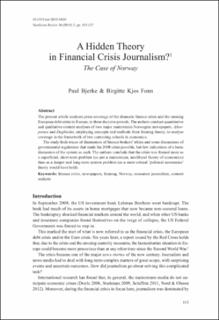| dc.description.abstract | The present article analyses press coverage of the dramatic finance crisis and the ensuing European debt crisis in Europe, in three decisive periods. The authors conduct quantitative and qualitative content analyses of two major mainstream Norwegian newspapers, Aften-posten and Dagbladet, employing concepts and methods from framing theory, to analyse coverage in the framework of two contesting schools in economics. The study finds traces of discussions of finance brokers’ ethics and some discussions of governmental regulations that made the 2008 crisis possible, but few indications of a basic discussion of the system as such. The authors conclude that the crisis was framed more as a superficial, short-term problem (as per a mainstream, neoliberal theory of economics) than as a deeper and long-term system problem (as a more critical ‘political economics’ theory would have held) | en_US |
